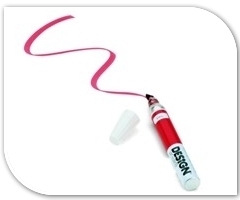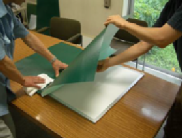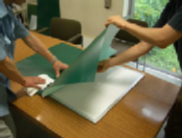Asthma is a condition characterized by inflammation of the lining of the airways and intermittent spasm of the underlying smooth muscle. Known asthma iscommonly attributed to work. This kind of asthma, often described as occupational asthma is prevalent amongst teachers and students. It is often but not always the result of allergy to an inhaled dust or vapour in classrooms. Its symptoms include coughing, wheezing, chest tightness and shortness of breath which improves on days off work or longer holidays, but the association with work may be difficult to establish in some cases.
Chalk dust is the natural by-product of using a chalk crayon on a blackboard. As the chalk is scraped across the rough surface of the chalkboard, particles of chalk dust are sent out into the surrounding air. Some of this chalk dust settles to the ground or is ventilated outside, but much of it falls on clothing, furniture, electronic equipment and shelves. Teachers and students inhale a portion of this chalk dust, which usually becomes trapped in the mucus layers of the throat and upper lungs. Small amounts of inhaled chalk dust is not considered harmful. Those with healthy respiratory systems can expel the chalk dust through coughing, and the remaining material should be absorbed safely into the body. For those with chronic breathing issues such as asthma, however, exposure to chalk dust can trigger a reaction. School systems strongly urge teachers to move students with respiratory problems away from the chalkboard area. Chalkboards, trays and dusters filled with chalk dust should also be cleaned regularly.
Standard chalk for classroom use is generally made from calcium carbonate, a processed form of natural limestone. The traditional method of creating white chalk was to form a claylike paste with the calcium carbonate and allow it to cure in chalk-shaped moulds.
Manufacturers have developed dustless chalk designed to address the chalk dust issue. Instead of forming chalk crayons through individual moulds, the new chalk mixture is extruded into ropes, then cut to size and allowed to dry. This dustless chalk does generate a form of chalk dust, but the particles are much heavier and tend to fall directly to the floor instead of floating in the air. Exposure to airborne chalk dust has been reduced, but the accumulation of chalk dust elsewhere is still problematic.
Chalk dust is considered an irritant and an occupational hazard in schools. If you must work around chalk dust for extended periods of time, many safety experts suggest using a filtered mask over your mouth and nose and taking a number of breaks in a fresh air environment. Use other dustless methods of communication, such as dry erase boards or overhead projectors, whenever possible. The traditional chalkboard also known as the blackboard has been replaced in many school classrooms with white boards. Changing from traditional chalkboards to white boards decreases allergy symptoms and attacks in the classrooms, eliminates the negative effects that chalk dust leaves on all surfaces and air and increases student retention in a school.













